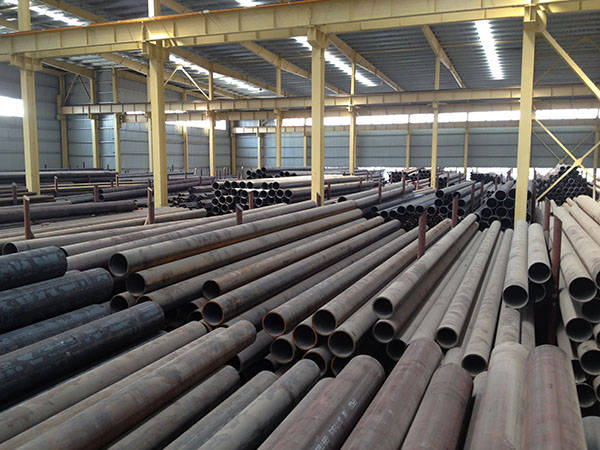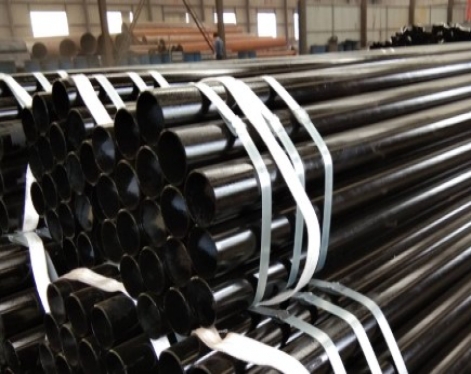Phosphating is a process in which chemical and electrochemical reactions form a phosphate conversion film, and the formed phosphate conversion film is referred to as a phosphating film. It can play a great role in improving the rust resistance of steel pipes (such as seamless pipes or welded pipes). When we are phosphating steel pipes, we should pay attention to the following five points:
1. Overflow washing
It is best to wash the overflow with water to ensure that the square tube is fully cleaned and reduce the phenomenon of crossing. When overflowing, water should enter from the bottom, and an overflow hole is opened on the top of the diagonal to overflow.
2. Phosphating and slag removal
For any kind of phosphating solution, more or less sediment will be generated, and the phosphating and slag removal device should be indicated when the process is designed. Especially when spraying and phosphating rectangular tubes, the slag removal device is essential. Typical slag removal devices include: inclined plate settler, high-level sedimentation tower, centrifugal slag remover, paper bag filter residue, etc. are available.
3.Interval time
If the interval between each process is too long, it will cause secondary rusting of the steel pipe during use. Especially when there is a pickling process, the pipes are easy to oxidize, rust and turn green in the air after pickling. It is best to have a water film protection between processes to reduce rust. However, the interval time is short, and the water cannot be completely and effectively drained, resulting in the phenomenon of stringing grooves, and even the bath liquid is destroyed. Therefore, when considering the process interval of square rectangular tubes, an appropriate interval should be selected according to the situation.
4.tank heating tube
Although the selection of the material of the tank heating tube is not the content of the process design, if it is not reminded, it may cause the negligence of the equipment designer. When pickling with sulfuric acid and hydrochloric acid, the tank body materials can only be selected from fiberglass, granite, and plastics, and the heating tube can only be selected from lead-antimony alloy tubes and ceramic tubes, instead of stainless steel. If pickling with phosphoric acid is adopted, the material of the tank body and the heating pipe can be made of stainless steel, of course, glass fiber reinforced plastics, plastics, and granite can all be used.
5. Process hole
For steel pipes that are easy to form dead corners and store water, it is necessary to choose an appropriate position to drill the process holes to ensure that the water can be fully drained in a short period of time. Otherwise, it will cause string grooves or drain in the air for a long time, resulting in secondary rust and affecting the phosphating effect.

Steel pipe phosphating requirements
1. The degreasing and pickling of the steel pipe should be clean, and there should be no rust after the previous treatment.
2. The phosphating layer should be uniform, and there must be no places that have not been phosphated.
3. After phosphating, complete rinsing should be carried out, and there should be no yellowish liquid in the tube.
4. Dry after rinsing to prevent rust. The appearance of the phosphating film should be a dense, continuous and uniform light gray to dark gray film. The following defects are allowed: slight water stains, chromate traces, slight dusting. The following defects are not allowed: yellowing and rusting of the phosphating film, loose phosphating film, no film at the bottom of the phosphating film, and serious ash.
5. The weight of phosphating film for painting should be less than 7.5 g/m2.
6. After cleaning, the inside of the pipe should be coated with anti-rust oil, and there should be no oil on the outer wall of the pipe (the outer surface should be painted).
7. The nozzle should be sealed with a cap.
1. Overflow washing
It is best to wash the overflow with water to ensure that the square tube is fully cleaned and reduce the phenomenon of crossing. When overflowing, water should enter from the bottom, and an overflow hole is opened on the top of the diagonal to overflow.
2. Phosphating and slag removal
For any kind of phosphating solution, more or less sediment will be generated, and the phosphating and slag removal device should be indicated when the process is designed. Especially when spraying and phosphating rectangular tubes, the slag removal device is essential. Typical slag removal devices include: inclined plate settler, high-level sedimentation tower, centrifugal slag remover, paper bag filter residue, etc. are available.
3.Interval time
If the interval between each process is too long, it will cause secondary rusting of the steel pipe during use. Especially when there is a pickling process, the pipes are easy to oxidize, rust and turn green in the air after pickling. It is best to have a water film protection between processes to reduce rust. However, the interval time is short, and the water cannot be completely and effectively drained, resulting in the phenomenon of stringing grooves, and even the bath liquid is destroyed. Therefore, when considering the process interval of square rectangular tubes, an appropriate interval should be selected according to the situation.
4.tank heating tube
Although the selection of the material of the tank heating tube is not the content of the process design, if it is not reminded, it may cause the negligence of the equipment designer. When pickling with sulfuric acid and hydrochloric acid, the tank body materials can only be selected from fiberglass, granite, and plastics, and the heating tube can only be selected from lead-antimony alloy tubes and ceramic tubes, instead of stainless steel. If pickling with phosphoric acid is adopted, the material of the tank body and the heating pipe can be made of stainless steel, of course, glass fiber reinforced plastics, plastics, and granite can all be used.
5. Process hole
For steel pipes that are easy to form dead corners and store water, it is necessary to choose an appropriate position to drill the process holes to ensure that the water can be fully drained in a short period of time. Otherwise, it will cause string grooves or drain in the air for a long time, resulting in secondary rust and affecting the phosphating effect.

Steel pipe phosphating requirements
1. The degreasing and pickling of the steel pipe should be clean, and there should be no rust after the previous treatment.
2. The phosphating layer should be uniform, and there must be no places that have not been phosphated.
3. After phosphating, complete rinsing should be carried out, and there should be no yellowish liquid in the tube.
4. Dry after rinsing to prevent rust. The appearance of the phosphating film should be a dense, continuous and uniform light gray to dark gray film. The following defects are allowed: slight water stains, chromate traces, slight dusting. The following defects are not allowed: yellowing and rusting of the phosphating film, loose phosphating film, no film at the bottom of the phosphating film, and serious ash.
5. The weight of phosphating film for painting should be less than 7.5 g/m2.
6. After cleaning, the inside of the pipe should be coated with anti-rust oil, and there should be no oil on the outer wall of the pipe (the outer surface should be painted).
7. The nozzle should be sealed with a cap.









